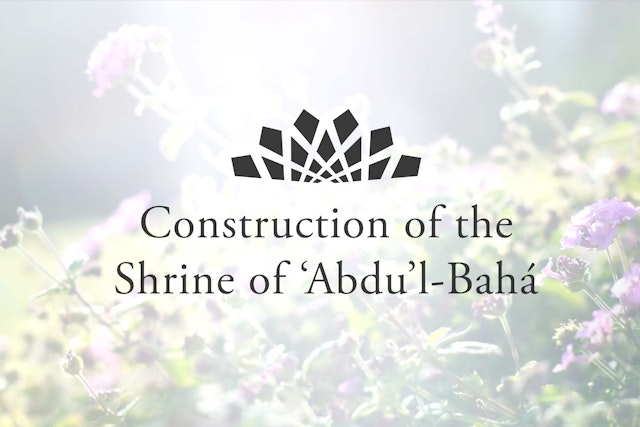The construction of the Shrine of ‘Abdu’l-Bahá is a remarkable narrative that encapsulates profound spiritual significance and cultural heritage. Positioned on Mount Carmel in Haifa, Israel, this architectural endeavor not only serves as a mausoleum for ‘Abdu’l-Bahá, but also stands as a monument to the essence of Bahá’í teachings. A thorough examination of this documentary illustrates the intersection of faith, craftsmanship, and community, thus piquing curiosity and promising a transformative perspective about the Bahá’í Faith and the legacy of its central figures.
The Shrine commemorates ‘Abdu’l-Bahá, the son of Bahá’u’lláh, the founder of the Bahá’í Faith. ‘Abdu’l-Bahá’s life was steeped in storytelling and action, urging the world towards unity and peace. He exemplified the very tenets of the Bahá’í Faith through his devoted service, and the construction of this shrine represents the culmination of his earthly journey. Crafted with exquisite artistry, the architecture epitomizes not just an architectural feat but a divine tribute to a life devoted to spreading the message of Bahá’u’lláh.
As the documentary unfolds, viewers are led through the meticulous planning and execution of the shrine’s construction. The narrative promotes a deeper understanding of the spiritual principles that guided its creation. Each stone, each design element imbued with symbolism, underscores the Bahá’í commitment to beauty and harmony. The meticulous craftsmanship parallels the teachings of the Faith, emphasizing how each individual plays a pivotal role in the unity of humanity.
The documentary not only details the physical aspects of the shrine but also explores the community’s involvement in the project. The construction represents a collective effort, a model for collaboration that transcends individual differences. This aspect resonates with the Bahá’í belief in the oneness of humanity. The diverse contributions from members worldwide signify that the shrine is not merely a local project, but a global initiative fostering unity across cultures and backgrounds.
Throughout the narrative, the producers juxtapose the construction phases with philosophical reflections. Quotations and teachings of ‘Abdu’l-Bahá illuminate the screen, turning the construction site into a living expression of his words. This literary elegance invites the audience to contemplate deeper themes. It poses poignant questions: What does it mean to build something of lasting significance? How does architecture reflect collective aspirations? These inquiries serve as an intriguing portal inviting viewers to engage with their own beliefs and values.
Moreover, the documentary sheds light on the climate and environmental considerations enveloping the construction project. The Bahá’í teachings advocate for the stewardship of the Earth, and the documentary illustrates how this principle was woven into the foundation of the shrine. From sourcing materials sustainably to implementing eco-friendly practices during construction, the project reflects an ethos of respect for nature. This commitment to environmental justice resonates deeply with contemporary audiences striving for a harmonious coexistence with the planet.
As viewers are led through the structure’s architectural marvels — from the intricately designed gardens to the golden dome — each element is framed within the context of spiritual significance. The design was meticulously crafted to symbolize various Bahá’í principles, such as unity and the pursuit of excellence. The narrative refrains from presenting these elements as mere aesthetic features; instead, they emerge as profound reminders of the Faith’s core values. The documentary thus ignites curiosity about the stories behind each design choice and what they reveal about ‘Abdu’l-Bahá’s life and messages.
One of the most engaging aspects of the documentary is how it intersperses interviews with architects, historians, and Bahá’í scholars. These voices enrich the narrative, providing multifaceted perspectives on the shrine’s importance. Each contributor elucidates how the shrine not only memorializes ‘Abdu’l-Bahá but also serves as an active center of Bahá’í pilgrimage and community gatherings. This dynamic reaffirms the role of sacred spaces in fostering spiritual growth and communal solidarity.
The viewer is further invited to consider how the shrine acts as a catalyst for dialogue. In a world rife with division, the teachings of ‘Abdu’l-Bahá advocate for reconciliation and understanding. The documentary underscores the shrine’s importance as a beacon of hope, where individuals from all backgrounds can converge to reflect, learn, and share. This positioning invites individuals to ponder the impacts of their faith and practices on their lives and communities.
Conclusively, “A Short Documentary on the Construction of the Shrine of ‘Abdu’l-Bahá” encapsulates an array of themes that extend far beyond its visual representation. It serves not only as an exposition of architectural splendor, but also as a profound reflection on the central teachings of the Bahá’í Faith. By intertwining architectural ingenuity with spiritual depth, the documentary catalyzes a shift in perspective, challenging viewers to engage earnestly with the principles of unity, service, and environmental stewardship. Each element prompts introspection, compelling the audience to re-evaluate their relationship with faith, community, and the world at large. Ultimately, it stands as a testament to how sacred spaces can inspire humanity towards a collective vision of peace and understanding.
